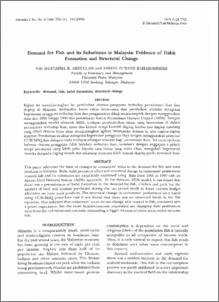Citation
Raja Abdullah, Nik Mustapha and Baharumshah, Ahmad Zubaidi
(1999)
Demand for fish and its substitutes in Malaysia: evidence of habit formation and structural change.
Pertanika Journal of Social Sciences & Humanities, 7 (2).
pp. 111-119.
ISSN 0128-7702; ESSN: 2231-8534
Abstract
This paper addresses the issue of changes in consumers' tastes in the demand for fish and meat products in Malaysia. Both, habit persistent effect and structural change in consumers' preferences towards fish and its substitutes are empirically examined using data from 1960 to 1990 with an Almost Ideal Demand System (AIDS) approach. In the dynamic AIDS model, it was found that there was a pervasiveness of habit formation in the demand for fish, chicken and pork but the amount of beef and mutton purchased during the last period tends to lower current budget allocation on these meat products. The structural change in consumers' preferences were tested using CUSUMSQ procedure and it was found that there was no structural break in the fish equation. This indicates that consumers' tastes do not change with respect to fish, consistent with
a priori expectation, but the more health-conscious population are changing their preferences away from the red meats and currently demanding a bigger amount of white meat, which includes fish.
Download File
![[img]](http://psasir.upm.edu.my/style/images/fileicons/application_pdf.png)  Preview |
|
PDF
Demand_for_Fish_and_its_Substitutes_in_Malaysia.pdf
Download (4MB)
|
|
Additional Metadata
Actions (login required)
 |
View Item |

